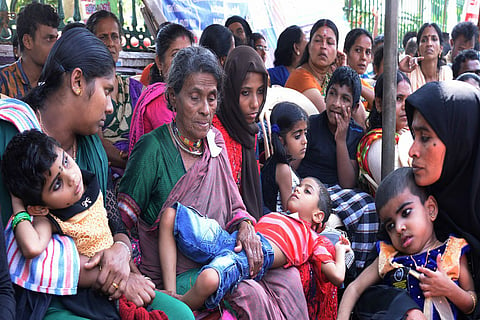

Travelling with Nandana, a 14-year-old intellectually disabled child, all the way from Kasargode district in the northern end of Kerala to Thiruvananthapuram in the south is not an easy task for her mother Chandravathi.
Nandana is a victim of the excessive aerial spraying of the pesticide endosulfan in Kasargode. She has come along with scores of children like her along with their parents. They have all come to protest in front of the Secretariat, the state administrative headquarters, on Tuesday to urge the government to disburse the compensation to all endosulfan victims.
Nandana has only the brain growth of a two-year-old and Chandravathi takes care of her like she is a child.
“I haven’t slept for the last 14 years since Nandana doesn’t sleep at night. She sleeps once in five days, but by 12 in the night she would wake up and start walking. My husband, my elder daughter and I aren’t able to sleep after this. Just imagine the task of travelling with her the whole night. I haven’t worked for 14 years neither have I stepped outside the house unless there is an emergency. Our whole family has got used to this now,” Chandravathi told TNM.
Nandana is among the for endosulfan victims who have received compensation from the government.
“But we have to take part in the protest for others. We view it as an issue of the entire district, not simply that of an individual or a family,” said Chandravathi, who hails from Pallikkara panchayat.
Like Nandana and Chandravathi, nearly 250 persons, including children and women, are participating in the protest under the aegis of Endosulfan Peeditha Janakeeya Munnani. The protest was inaugurated by well-known activist Daya Bai.
“We are sad that the children with disabilities and their mothers have to travel long distances to stage the protest. But we have no other option. If a favourable response doesn’t come by mid-March, we will start an indefinite strike. What we have done today is a token strike,” said Ambalathara Kunjikrishnan, Secretary of the Munnani.
Why the protest?
The prime demand is to include all the victims, battling various diseases from mental and physical disability to cancer, of the decades-long pesticide spraying in the cashew plantations of the state-owned Plantation Corporation in the district. Though the spraying of the pesticide stopped way back in 2000 owing to widespread protests and health issues caused by it, the ill-effects have been passed on to the next generation. The people of 11 panchayats and Kanjagad Municipality have been affected by the spraying in the district, which is the gravest human issue that the state has witnessed for years.
The spraying began in the late 70s and continued for more than 20 years. The resulting diseases have been transmitted to generations over the years. Hundreds of children are born with congenital defects, which have changed the fate of their families as there is no permanent cure for these diseases.
The last time the government conducted a medical camp was in mid-2017. After examining the patients at the camp, as many as 1,905 people were listed as victims of the pesticide spraying. But an endosulfan cell functioning in the district with the Collector as chairman changed the number to 287 persons, saying that non-deserving people had also found place in the list.
Another demand of the protesters is the implementation of the 2017 Supreme Court order regarding compensation for the victims. The SC had directed that a compensation of Rs 5 lakh and lifetime treatment should be given to each of the victims. The order was the result of a petition filed by DYFI, the youth wing of the CPI (M). The government so far hasn’t followed the SC order fully. At the time the SC issued the order, the number of endosulfan victims were 5,848. Only 2,665 people out of that have been given compensation.
In March 2017, the government had disbursed Rs 56.76 crore for the victims. But the protesters alleged that it didn’t cover all the victims as per the SC order and that there are still 3,183 people who are to be given compensation.
The protesters also demand that a permanent tribunal be set up to find out the new victims to be included in the list and to ensure that compensation is given to all deserving people.
“In the medical camp there were specialist doctors who decided who are the victims. How did the district administration decide that they don’t deserve compensation? With this change, several families who earlier had Below Poverty Line (BPL) ration cards lost their priority to be included in the BPL list. The ration cards have been changed to APL which deprived the families the benefits they used to get as BPL cardholders,” said Subramanian, who is part of the Munnani.
Another demand of the victims’ families is to write off the bank loans availed by them to meet the treatment expenses for the victims.
“The interest from these loans is mounting. The government should take a stand on this,” urged Subramanian.
Government apathy
“During the tenure of the Congress-led United Democratic Front government, the medical camp was conducted only once. The victims had done a day-night protest at the then Chief Minister Oommen Chandy’s official residence demanding that compensation be disbursed. The Left, which was in the Opposition then, had given us support against the government. The DYFI had even approached the court. Now the Left is in power and we are fighting for the same cause. I don’t know why the government is reluctant to even carry out the SC’s orders. At present we have the support only of the media, not even that of human rights activists,” said Kunjikrishnan.
“The government is keen to add people older than 70 in the endosulfan list… maybe because there won’t be a need to support them for long,” he lamented.